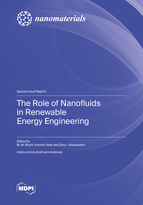The Role of Nanofluids in Renewable Energy Engineering
A special issue of Nanomaterials (ISSN 2079-4991). This special issue belongs to the section "Energy and Catalysis".
Deadline for manuscript submissions: closed (28 February 2023) | Viewed by 28348
Special Issue Editors
Interests: mathematical physics; nonlinear waves; numerical simulations; perturbation methods; single- and multi-phase thermofluids; magnetohydrodynamics; nanofluids
Special Issues, Collections and Topics in MDPI journals
Interests: porous media; multiphase transport; aircraft brakes; micro cantilever based biosensors; biofilms; macromolecule transport through arteries; cooling enhancement investigations; modeling of tissue and organs; natural convection in complex configurations; analysis of porous insulations; heat flux applications; free surface flows; flat-shaped heat pipes; thermal design and modeling; feasibility; optimization; parametric studies for various engineering applications and power electronics
Special Issues, Collections and Topics in MDPI journals
Interests: applied mathematics; fluid mechanics; blood flows; nanofluids
Special Issues, Collections and Topics in MDPI journals
Special Issue Information
Dear Colleagues,
Nanofluid flows inherently involve multi-scale and complex physics. A wide variety of modelling and experimental techniques have been already applied to the investigation of nanofluids from the fundamental and applied viewpoints. Physical understanding and research tools have been developed considerably and further major contributions are expected to be made.
In recent years, thermal technology has faced various challenges, and obtaining a higher heat transfer rate is a major problem. The higher temperatures achieved through the combustion of fossil fuels are often not readily achieved by renewable energies. Nanofluids are beneficial in resolving these issues. The basic concept of heat transfer enhancement by nanofluids is now well established. Some important areas still require further investigation, in order to apply nanofluids to energy technologies. It involves interactions between the nanoparticles and the base fluid and their subsequent influences upon heat convection. Further, the large-scale utilisation of nanofluids in renewable energy technologies remains a largely unexplored area. The former leads to investigations on the modifications of fluid and flow behaviours in nanofluids, while the latter involves studies of nanofluids in solar thermal and geothermal technologies, heat storage and networks as well as a wide range of technologies for heat recovery. An ongoing challenge on all of these fronts is the development of accurate and yet affordable computational tools that can predict the heat transfer behaviours of nanofluids. This, in turn, requires the further experimental examination of nanofluids at the system level, such as those in solar thermal collectors and geothermal boreholes and other large-scale renewable energy systems.
The decarbonisation of energy through the transition from fossil fuels to renewables is a tremendous task that faces the engineering research community. Thermal energy constitutes a major fraction of the consumed energy in many parts of the world and is a significant contributor to the emission of greenhouse gases. Many countries have recently decided to decarbonise their heat sectors. As a result, carbon-free thermal technologies such as solar thermal, geothermal, heat pumps, heat storage, and heat networks are receiving ever-increasing attention. Central to all these is the problem of heat transfer.
This Special Issue aims to bring together the latest research findings on heat transfer by nanofluids with a strong emphasis on the problems related to renewable energy.
More specifically, modelling and experimental works on the following topics are of immediate interest. For instance:
- Numerical simulation related to the potential applications of nanofluids engineering;
- Analytical and numerical models for the applications of nanofluids;
- The application of novel nanofluids to renewable energy engineering;
- The rheology of nanofluids in renewable energy engineering;
- The application of Hybrid nanofluids;
- Thermo-hydraulics of nanofluids in renewable energy technologies;
- Techno-economics of nanofluids in renewable energy systems;
- The fouling and clustering of nanoparticles in renewable energy systems.
Further, this Special Issue welcomes contributions on micro-, meso- and macro-scale modelling approaches to heat transfer in nanofluids and those on the novel numerical, experimental and theoretical techniques pertinent to nanofluids.
Dr. M. M. Bhatti
Prof. Dr. Kambiz Vafai
Dr. Sara I. Abdelsalam
Guest Editors
Manuscript Submission Information
Manuscripts should be submitted online at www.mdpi.com by registering and logging in to this website. Once you are registered, click here to go to the submission form. Manuscripts can be submitted until the deadline. All submissions that pass pre-check are peer-reviewed. Accepted papers will be published continuously in the journal (as soon as accepted) and will be listed together on the special issue website. Research articles, review articles as well as short communications are invited. For planned papers, a title and short abstract (about 100 words) can be sent to the Editorial Office for announcement on this website.
Submitted manuscripts should not have been published previously, nor be under consideration for publication elsewhere (except conference proceedings papers). All manuscripts are thoroughly refereed through a single-blind peer-review process. A guide for authors and other relevant information for submission of manuscripts is available on the Instructions for Authors page. Nanomaterials is an international peer-reviewed open access semimonthly journal published by MDPI.
Please visit the Instructions for Authors page before submitting a manuscript. The Article Processing Charge (APC) for publication in this open access journal is 2900 CHF (Swiss Francs). Submitted papers should be well formatted and use good English. Authors may use MDPI's English editing service prior to publication or during author revisions.
Keywords
- Nanofluids and Hybrid nanofluids
- Magnetohydrodynamics
- Porous media
- Nanotechnology
- Biological flows
- Renewable Energy Engineering
- Shape effects of nanoparticles
- Numerical and analytical simulation









